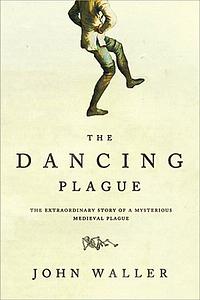You need to sign in or sign up before continuing.
Take a photo of a barcode or cover
Fascinating read and looks into social/political era that allowed the dancing plague to happen. Also for non fiction it was a really easy read
Apparently 1518 was the last time there was an epidemic like this, but it had happened a number of other times in the Middle Ages. What this book does is go through the social background in order to give an explanation for them, and most especially for this (worst) dancing plague in Strasbourg. Basically, it's all caught up with extreme poverty due to several years' failed crops, corruption in the clergy (excessive wealth, sexual shenanigans) which caused the populace to be sure that the clergy could not intervene with God on their behalf, and superstition. The mixed messages about dancing fed the psychological dissonance of the time, and thus extreme stress and trauma manifested in this "choreomania" (dancing plague).
I was intrigued by the mention of a dancing epidemic in 1237 (in Erfurt) when '100 or more children are supposed to have danced and hopped out of the town's gates. ... The children were later found by their distraught and bemused parents; by then some of them were already dead and others were afflicted with tremors and fatigue for the rest of their lives. (p.8)'
This is a very readable book - the author is a historian who writes so that the layperson can read and enjoy the subject.
I was intrigued by the mention of a dancing epidemic in 1237 (in Erfurt) when '100 or more children are supposed to have danced and hopped out of the town's gates. ... The children were later found by their distraught and bemused parents; by then some of them were already dead and others were afflicted with tremors and fatigue for the rest of their lives. (p.8)'
This is a very readable book - the author is a historian who writes so that the layperson can read and enjoy the subject.
informative
slow-paced
1518 was a very bad year, with famine and religious insecurities stoked by the nascent Reformation. Across Germany, peasants began a deadly, frantic and seemingly involuntary public dance--was it ergot? penitential religious mania? demonic possession? With insights from modern biochemistry and psychology, Waller attempts to unravel this Early Modern ""dance of death."
This is one of those books that reminds me why I love history.
In the summer of 1518 in Strasbourg (modern day France) 2-400 people danced uncontrollably for days on end. No kidding. Some even danced until they died of exhaustion. For the first half of the book I had a hard time believing Mr Waller wasn't jerking me around.
Mr Waller spends a few chapters establishing the world and worldview that people of 16th century Strasbourg lived in and uses that to argue that the dancers were actually in a trance and believed themselves to be under the curse of St Vitus (Catholic saints, occasionally they're a little crazy). After recounting the history and aftermath of the plague, Mr Waller spends the last two chapter recounting other stories of how people in different times and cultures react to stressful situations and behave in a 'trance'.
I think the last chapter really sold me on the book. After the author claimed the dancing was done in a trance, I was skeptical that that was possible but after reading the last chapter and seeing that while the dancing is unique to a time and place, the act of involuntarily acting in some culture specific way is widespread across the globe I'm more open minded on the subject.
And finally, kudos for covering a really odd event.
In the summer of 1518 in Strasbourg (modern day France) 2-400 people danced uncontrollably for days on end. No kidding. Some even danced until they died of exhaustion. For the first half of the book I had a hard time believing Mr Waller wasn't jerking me around.
Mr Waller spends a few chapters establishing the world and worldview that people of 16th century Strasbourg lived in and uses that to argue that the dancers were actually in a trance and believed themselves to be under the curse of St Vitus (Catholic saints, occasionally they're a little crazy). After recounting the history and aftermath of the plague, Mr Waller spends the last two chapter recounting other stories of how people in different times and cultures react to stressful situations and behave in a 'trance'.
I think the last chapter really sold me on the book. After the author claimed the dancing was done in a trance, I was skeptical that that was possible but after reading the last chapter and seeing that while the dancing is unique to a time and place, the act of involuntarily acting in some culture specific way is widespread across the globe I'm more open minded on the subject.
And finally, kudos for covering a really odd event.
informative
medium-paced
informative
tense
slow-paced
John Waller wrote a book about the dancing plague of 1518. If you are like me and the majority of people, you have not heard of the dancing plague of 1518 but as soon as you read on the back cover that in 1518 in Strasbourg dozens of people danced themselves to death you immediately want to know 'what the hell!'.
That's what Waller's book selling point is - he will tell you what the hell. But first he will tell you all the other theories that were used to explain the phenomenon. Initially, of course, demonic possession. Then the curse of St Vitus. Then overheating of the head. Then some parasite...
But John Waller claims that the REAL reason a hundred of people started to dance and couldn't stop [watch out, here be the spoilers] is because they all went loco. Well, if you ask me, demonic possession sounds about right.
Waller eventually makes a good case for his 'gone loco' theory. His main argument is that when people who are under a lot of stress and pressure break down they do so still within their cultural and sociological frame. As in - they break down they way they are supposed to break down.
Back in 1518 demonic possession was all the rave. Currently it is more en vogue to quit your job, cry, eat a lot of unhealthy food and watch daytime tv. O tempora o mores!
Let's take this moment to think about and mourn the victims of the dancing plague of 1815 to whom I would like to dedicate this:
http://www.youtube.com/watch?v=CZkjeJKBI0M
That's what Waller's book selling point is - he will tell you what the hell. But first he will tell you all the other theories that were used to explain the phenomenon. Initially, of course, demonic possession. Then the curse of St Vitus. Then overheating of the head. Then some parasite...
But John Waller claims that the REAL reason a hundred of people started to dance and couldn't stop [watch out, here be the spoilers] is because they all went loco. Well, if you ask me, demonic possession sounds about right.
Waller eventually makes a good case for his 'gone loco' theory. His main argument is that when people who are under a lot of stress and pressure break down they do so still within their cultural and sociological frame. As in - they break down they way they are supposed to break down.
Back in 1518 demonic possession was all the rave. Currently it is more en vogue to quit your job, cry, eat a lot of unhealthy food and watch daytime tv. O tempora o mores!
Let's take this moment to think about and mourn the victims of the dancing plague of 1815 to whom I would like to dedicate this:
http://www.youtube.com/watch?v=CZkjeJKBI0M
informative
medium-paced
I feel that this book focused more on the concept of dancing plagues. It looked at multiple instances of them in medieval times and the contexts. So saying this book is about the one in 1518 feels a bit deceiving.






